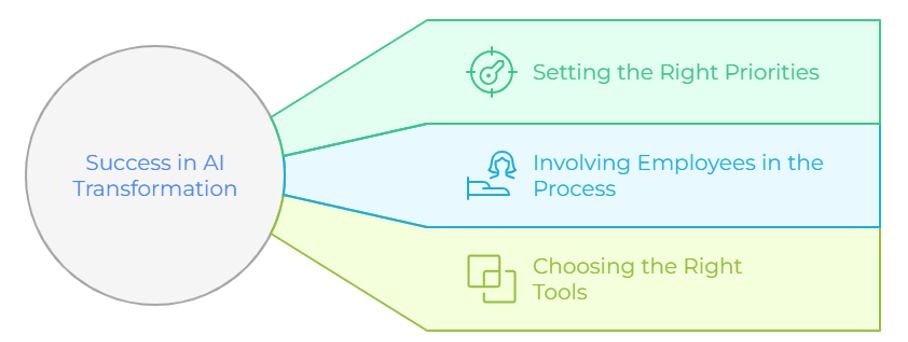Table of Contents
- 1. Introduction
- 2. Customer Service Automation
- 3. Content Creation and Marketing Materials
- 4. Report Preparation and Business Intelligence
- 5. Data Analysis and Visualization
- 6. Code Writing and Software Development
- 7. Meeting Summarization and Knowledge Management
- 8. Email Management and Communication Optimization
- 9. Document Processing and Document Analysis
- 10. Success Factors in AI Transformation
- 11. Key Considerations for Corporate Implementation
- 12. Conclusion
1. Introduction
AI transformation is now on the agenda not only for technology companies but for businesses across all sectors. Generative AI tools like ChatGPT, Claude, and Midjourney are fundamentally changing how organizations operate and providing significant productivity gains in the daily routines of knowledge workers.When we think of corporate AI transformation, large budgets, complex infrastructures, and lengthy implementation processes often come to mind. However, the reality is quite different. Generative AI tools like ChatGPT offer cost-effective solutions that can be used with minimal technical knowledge and deliver quick value. An employee with the right prompt writing skills can complete a significant portion of their daily tasks much faster and with higher quality using AI support.In this article, we’ll examine how organizations can use AI in their daily operations across 8 fundamental areas. We’ll explore the practical use of tools, the benefits that can be achieved, and implementation methods in each area.
2. Customer Service Automation
Customer service is one of the areas where AI transformation delivers the fastest impact. Language models like ChatGPT and Claude are highly successful at understanding customer questions, generating accurate responses, and establishing empathetic communication. Organizations can use these technologies across a wide range, from chatbots to automated response systems.The biggest advantage of AI-powered systems is their ability to provide 24/7 uninterrupted service. They can interact with hundreds or even thousands of customers simultaneously. While automatically responding to standard requests like frequently asked questions and order tracking, they can redirect complex situations to human representatives. This hybrid model both increases customer satisfaction and allows human representatives to focus on more valuable tasks. Multilingual support is another major advantage; instead of building separate teams for each language, companies can serve global customers with a single system.
3. Content Creation and Marketing Materials
Content marketing is one of the fundamental ways for brands to strengthen their visibility in today’s digital world, but quality content creation is a time-consuming process. ChatGPT and Claude provide support across a wide range of content, from blog posts to social media posts, email newsletters to product descriptions.Content teams can use AI at different stages such as brainstorming, drafting, rewriting, SEO optimization, and translation. Visual generation tools like Midjourney and DALL-E add a visual dimension to content strategy. Marketing teams can quickly generate visual alternatives for blog images, social media graphics, and advertising concepts. Personalization is another strength of AI; customized content variations can be easily created for different customer segments.
4. Report Preparation and Business Intelligence
Corporate reporting is a critical function that enables managers to make data-driven decisions. ChatGPT and Claude automate the data collection, analysis, and reporting process, both saving time and improving report quality.AI can take raw data and transform it into meaningful insights. It provides support across a wide range, from sales reports to financial summaries and operational reports. It can transform complex data into executive summaries and technical details into simple explanations. Automation of regular reporting processes also provides significant benefits; templates can be created for weekly or monthly reports, and AI can fill them with current data.
5. Data Analysis and Visualization
Data is one of the most valuable assets of modern businesses, but extracting value from this data requires technical skills. ChatGPT’s Code Interpreter feature and Claude’s analytical capabilities democratize data analysis, enabling even non-technical users to perform complex analyses.Users can run analyses with commands like “segment customers” or “analyze sales trends” without programming knowledge. AI performs the analysis, visualizes the results, and explains the findings. Special analysis types like sentiment analysis and text classification are also possible with AI. Automatic analysis of customer reviews, processing social media data, and categorizing survey responses can be done much faster and more scalably.
6. Code Writing and Software Development
Software development is one of the areas where AI has the most dramatic impact. Tools like GitHub Copilot, ChatGPT, and Claude speed up code writing, debugging, test creation, and documentation.AI code assistants complete the code developers write and offer suggestions. Routine coding tasks like repetitive code blocks and standard functions can be largely automated. Translation between different programming languages is another strength; modernization of legacy systems can be accomplished much faster. Creating test scenarios and writing code documentation, tasks developers often struggle to find time for, become easier.
7. Meeting Summarization and Knowledge Management
Meetings occupy an important place in corporate life, but information loss after meetings and forgotten decisions are common problems. ChatGPT and Claude solve these problems by processing meeting recordings and improving corporate knowledge management.AI working integrated with tools like Otter.ai and Fireflies.ai can automatically summarize meetings. Hours-long meetings turn into a few pages of summaries. It can automatically extract decisions made, action items, and important discussion points. This is especially valuable for global teams working in different time zones; team members who couldn’t attend live can quickly review the meeting through the summary.
8. Email Management and Communication Optimization
Email remains one of the fundamental channels of corporate communication. ChatGPT and Claude optimize email management, helping employees save time.AI assists across a wide range, from brief notes to professional emails, customer responses to internal communications. Tone adjustment, translation, grammar checking, shortening, or expanding can be done instantly. Prioritizing and categorizing incoming emails is another important use case. Emails can be automatically classified based on their content. The automatic draft response feature for routine emails is also very useful; users can review the draft and send it quickly.
9. Document Processing and Document Analysis
Organizations work with thousands of documents daily: contracts, invoices, reports, forms. Manual processing of these documents is both time-consuming and carries error risk. ChatGPT and Claude increase efficiency by automating document processing.AI can read and analyze documents in different formats. It can summarize long contracts, extract important clauses, and identify risks. For invoice and receipt processing, it can extract information using OCR technology and transfer it to accounting systems. Resume analysis and candidate evaluation is another important use case; AI can analyze resumes and score them according to position requirements, allowing HR professionals to focus on in-depth interviews rather than initial screening.
10. Success Factors in AI Transformation
The success of AI tools in corporate environments depends not only on technology selection but also on strategic approach. The fundamental factors of successful transformation are:
Setting the Right Priorities: Focusing on areas that will provide quick wins increases trust in AI within the organization. Starting with easy areas like email management and meeting summarization, then moving to complex processes is effective.
Engaging Employees: Training programs and sharing success stories increase employee participation. The message that AI is an opportunity, not a threat, is important.
Choosing the Right Tools: Selecting the most suitable tools for your needs and being able to integrate multiple tools when necessary creates strategic advantage.

11. Key Considerations for Corporate Implementation
Data Security and Privacy: Critical content like customer data and trade secrets should not be shared insecurely. Enterprise subscriptions offer advanced security features. Compliance with regulations like GDPR and KVKK is critical.Quality Control: AI can sometimes produce incorrect information. Human oversight is essential in sensitive areas like legal documents and financial reports. Rather than using content as-is because “AI said so,” it’s important to see AI as an assistant and have experts make the final decision.Dependency Risk: Over-reliance on a single provider creates risk. Maintaining alternative solutions and evaluating different providers is strategic. Cost control is also important; API usage can increase rapidly with heavy use.Ethics and Responsibility: There are risks like biased content production and copyright infringement. Organizations should establish ethical principles for AI use. Transparently indicating when AI is used is important, especially in customer communications.
12. Conclusion
AI transformation is today’s reality. Tools like ChatGPT, Claude, and Midjourney are fundamentally changing how organizations operate. The 8 use cases we examined in this article demonstrate how AI can create value in corporate environments.Starting with easy areas like email management and meeting summarization, then progressing to more complex processes creates a successful strategy. However, AI is not a magic wand; it requires the right strategy, planning, and implementation. Attention must be paid to factors like data security, quality control, ethical use, and employee training.The most important point is to see AI as a tool that empowers people, not replaces them. Organizations can extract maximum value from the opportunities AI offers by starting with small steps and scaling based on successful examples. Companies investing in AI today will be tomorrow’s competitive leaders.




